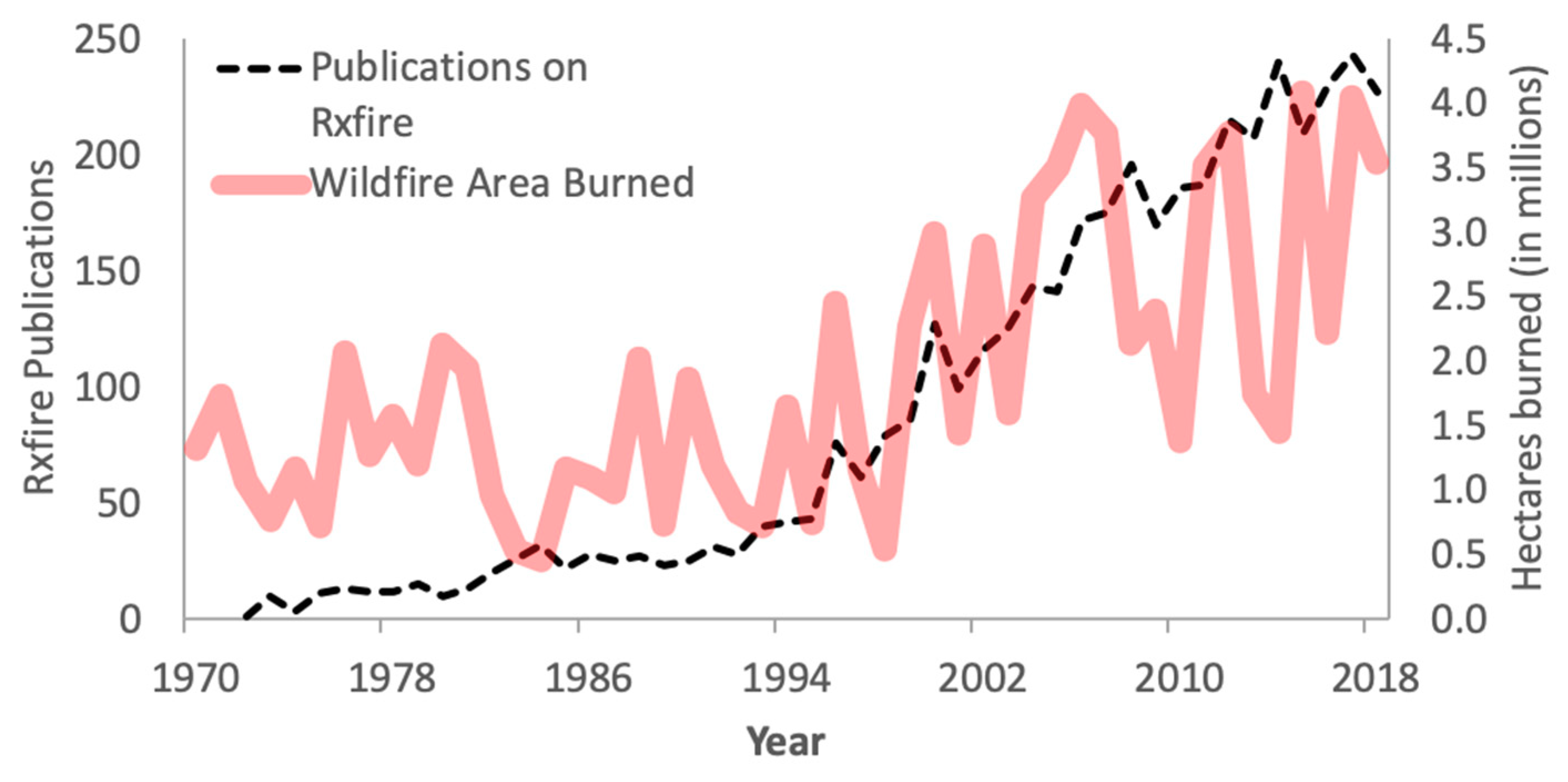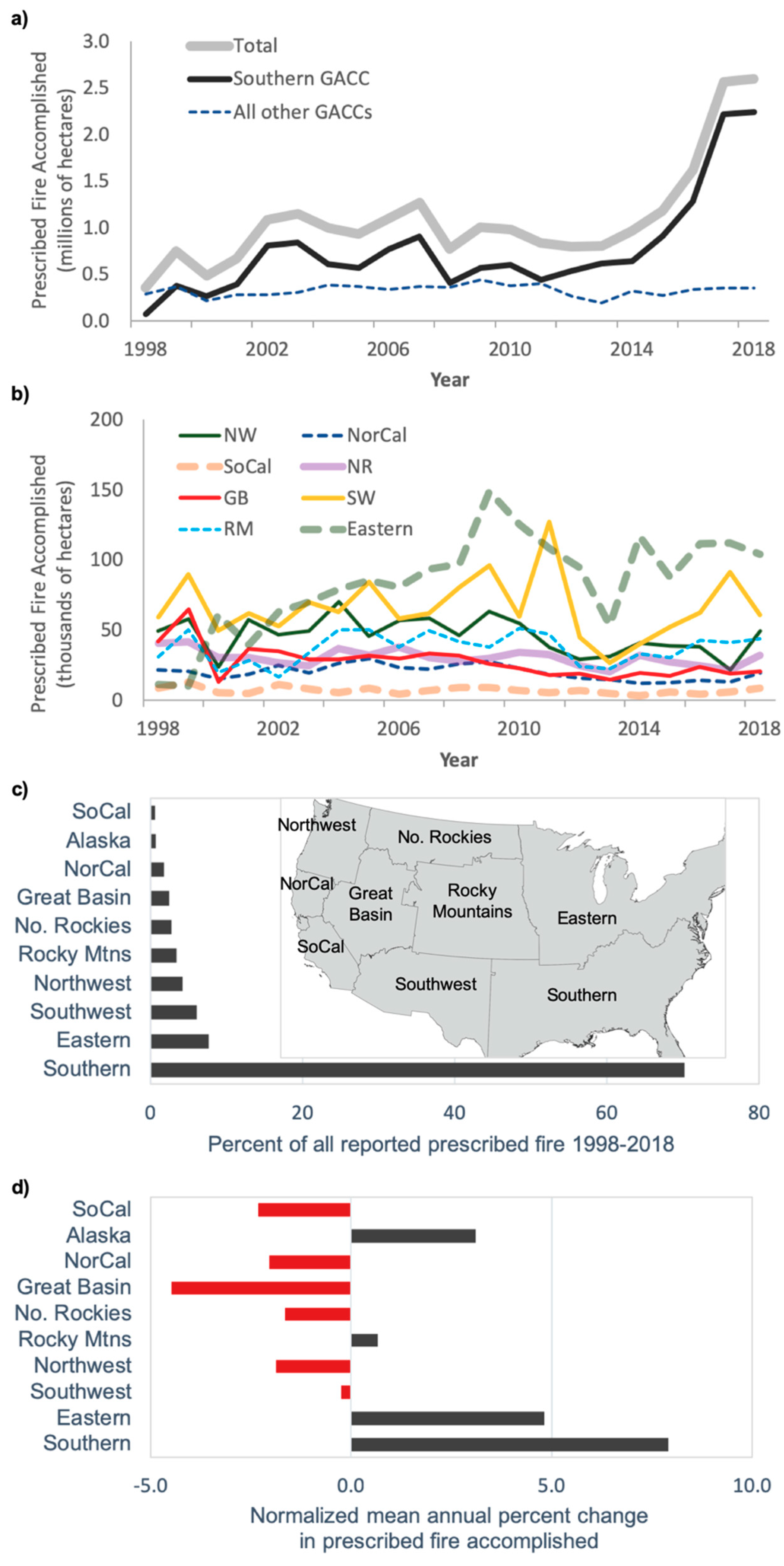We’re Not Doing Enough Prescribed Fire in the Western United States to Mitigate Wildfire Risk
Abstract
1. Introduction
2. Methods
3. Results
4. Discussion
Supplementary Materials
Funding
Acknowledgments
Conflicts of Interest
References
- Calkin, D.E.; Cohen, J.D.; Finney, M.A.; Thompson, M.P. How risk management can prevent future wildfire disasters in the wildland-urban interface. Proc. Natl. Acad. Sci. USA 2014, 111, 746–751. [Google Scholar] [CrossRef] [PubMed]
- Moritz, M.A.; Batllori, E.; Bradstock, R.A.; Gill, A.M.; Handmer, J.; Hessburg, P.F.; Leonard, J.; McCaffrey, S.; Odion, D.C.; Schoennagel, T.; et al. Learning to co-exist with wildfire. Nature 2014, 515, 58–66. [Google Scholar] [CrossRef] [PubMed]
- North, M.P.; Stephens, S.L.; Collins, B.M.; Agee, J.K.; Aplet, G.; Franklin, J.F.; Fule, P.Z. Reform forest fire management. Science 2015, 349, 1280–1281. [Google Scholar] [CrossRef] [PubMed]
- Schoennagel, T.; Balch, J.K.; Brenkert-Smith, H.; Dennison, P.E.; Harvey, B.J.; Krawchuk, M.A.; Mietkiewicz, N.; Morgan, P.; Moritz, M.A.; Rasker, R.; et al. Adapt to more wildfire in western North American forests as climate changes. Proc. Natl. Acad. Sci. USA 2017, 114, 4582–4590. [Google Scholar] [CrossRef]
- Fernandes, P.M.; Botelho, H.S. A review of prescribed burning effectiveness in fire hazard reduction. Int. J. Wildland Fire 2003, 12, 117–128. [Google Scholar] [CrossRef]
- Pollet, J.; Omi, P.N. Effect of thinning and prescribed burning on crown fire severity in ponderosa pine forests. Int. J. Wildland Fire 2002, 11, 1–10. [Google Scholar] [CrossRef]
- Vaillant, N.M.; Fites-Kaufman, J.A.; Stephens, S.L. Effectiveness of prescribed fire as a fuel treatment in Californian coniferous forests. Int. J. Wildland Fire 2009, 18, 165–175. [Google Scholar] [CrossRef]
- Wiedinmyer, C.; Hurteau, M.D. Prescribed fire as a means of reducing forest carbon emissions in the western United States. Environ. Sci. Technol. 2010, 44, 1926–1932. [Google Scholar] [CrossRef]
- Hurteau, M.; North, M. Fuel treatment effects on tree-based forest carbon storage and emissions under modeled wildfire scenarios. Front. Ecol. Environ. 2009, 7, 409–414. [Google Scholar] [CrossRef]
- Collins, B.M.; Das, A.J.; Battles, J.J.; Fry, D.L.; Krasnow, K.D.; Stephens, S.L. Beyond reducing fire hazard: Fuel treatment impacts on overstory tree survival. Ecol. Appl. 2014, 24, 1879–1886. [Google Scholar] [CrossRef]
- Smith, A.M.S.; Kolden, C.A.; Bowman, D.M. Biomimicry can help humans to coexist sustainably with fire. Nature Ecol. Evol. 2018, 2, 1827. [Google Scholar] [CrossRef]
- Larson, A.J.; Belote, R.T.; Cansler, C.A.; Parks, S.A.; Dietz, M.S. Latent resilience in ponderosa pine forest: Effects of resumed frequent fire. Ecol. Appl. 2013, 23, 1243–1249. [Google Scholar] [CrossRef]
- Fule, P.Z.; Cocke, A.E.; Heinlein, T.A.; Covington, W.W. Effects of an intense prescribed forest fire: Is it ecological restoration? Restor. Ecol. 2004, 12, 220–230. [Google Scholar] [CrossRef]
- Moore, M.M.; Covington, W.W.; Fulé, P.Z. Reference conditions and ecological restoration: A southwestern ponderosa pine perspective. Ecol. Appl. 1999, 9, 1266–1277. [Google Scholar] [CrossRef]
- Abatzoglou, J.T.; Williams, A.P. Impact of anthropogenic climate change on wildfire across western US forests. Proc. Natl. Acad. Sci. USA 2016, 113, 11770–11775. [Google Scholar] [CrossRef] [PubMed]
- Balch, J.K.; Bradley, B.A.; Abatzoglou, J.T.; Nagy, R.C.; Fusco, E.J.; Mahood, A.L. Human-started wildfires expand the fire niche across the United States. Proc. Natl. Acad. Sci. USA 2017, 114, 2946–2951. [Google Scholar] [CrossRef]
- Bowman, D.M.; Williamson, G.J.; Abatzoglou, J.T.; Kolden, C.A.; Cochrane, M.A.; Smith, A.M.S. Human exposure and sensitivity to globally extreme wildfire events. Nat. Ecol. Evol. 2017, 1, 0058. [Google Scholar] [CrossRef]
- Bowman, D.M.; Moreira-Muñoz, A.; Kolden, C.A.; Chávez, R.O.; Muñoz, A.A.; Salinas, F.; González-Reyes, Á.; Rocco, R.; de la Barrera, F.; Williamson, G.J.; et al. Human–environmental drivers and impacts of the globally extreme 2017 Chilean fires. Ambio 2019, 48, 350–362. [Google Scholar] [CrossRef] [PubMed]
- Stephens, S.L.; Agee, J.K.; Fule, P.Z.; North, M.P.; Romme, W.H.; Swetnam, T.W.; Turner, M.G. Managing forests and fire in changing climates. Science 2013, 342, 41–42. [Google Scholar] [CrossRef]
- Smith, A.M.S.; Kolden, C.A.; Paveglio, T.B.; Cochrane, M.A.; Bowman, D.M.; Moritz, M.A.; Kliskey, A.D.; Alessa, L.; Hudak, A.T.; Hoffman, C.M.; et al. The science of firescapes: Achieving fire-resilient communities. Bioscience 2016, 66, 130–146. [Google Scholar] [CrossRef]
- Wildland Fire Leadership Council. The National Strategy: The Final Phase in the Development of the National Cohesive Wildland Fire Management Strategy; Washington, DC, USA, 2014. Available online: https://www.forestsandrangelands.gov/strategy/thestrategy.shtml (accessed on 25 April 2019).
- Ryan, K.C.; Knapp, E.E.; Varner, J.M. Prescribed fire in North American forests and woodlands: History, current practice, and challenges. Front. Ecol. Environ. 2013, 11, e15–e24. [Google Scholar] [CrossRef]
- Stephens, S.L.; Ruth, L.W. Federal forest-fire policy in the United States. Ecol. Appl. 2005, 15, 532–542. [Google Scholar] [CrossRef]
- Kimmerer, R.W.; Lake, F.K. The role of indigenous burning in land management. J. For. 2001, 99, 36–41. [Google Scholar]
- Lake, F.K.; Wright, V.; Morgan, P.; McFadzen, M.; McWethy, D.; Stevens-Rumann, C. Returning fire to the land: Celebrating traditional knowledge and fire. J. For. 2017, 115, 343–353. [Google Scholar] [CrossRef]
- Rasmussen, K.; Hibbard, M.; Lynn, K. Wildland fire management as conservation-based development: An opportunity for reservation communities? Soc. Nat. Resour. 2007, 20, 497–510. [Google Scholar] [CrossRef]
- Ray, L.; Kolden, C.A.; Chapin, F., III. A case for developing place-based fire management strategies from traditional ecological knowledge. Ecol. Soc. 2012, 17, 37. [Google Scholar] [CrossRef]
- Broome, R.A.; Johnston, F.H.; Horsley, J.; Morgan, G.G. A rapid assessment of the impact of hazard reduction burning around Sydney, May 2016. Med. J. Aust. 2016, 205, 407–408. [Google Scholar] [CrossRef]
- Kolden, C.A.; Brown, T.J. Beyond wildfire: Perspectives of climate, managed fire and policy in the USA. Int. J. Wildland Fire 2010, 19, 364–373. [Google Scholar] [CrossRef]
- Quinn-Davidson, L.N.; Varner, J.M. Impediments to prescribed fire across agency, landscape and manager: An example from northern California. Int. J. Wildland Fire 2012, 21, 210–218. [Google Scholar] [CrossRef]
- Haugo, R.; Kellogg, B.S.; Cansler, C.A.; Kolden, C.A.; Kemp, K.B.; Robertson, J.; Metlen, K.L.; Vaillant, N.M.; Restaino, C.M. The Missing Fire: Quantifying human exclusion of wildfire in Pacific Northwest forests, USA. Ecosphere 2019, 10, e02702. [Google Scholar] [CrossRef]
- Parks, S.A.; Miller, C.; Parisien, M.A.; Holsinger, L.M.; Dobrowski, S.Z.; Abatzoglou, J. Wildland fire deficit and surplus in the western United States, 1984–2012. Ecosphere 2015, 6, 1–13. [Google Scholar] [CrossRef]
- Williams, J. Exploring the onset of high-impact mega-fires through a forest land management prism. For. Ecol. Manag. 2013, 294, 4–10. [Google Scholar] [CrossRef]
- Haines, T.K.; Busby, R.L.; Cleaves, D.A. Prescribed burning in the South: Trends, purpose, and barriers. South. J. Appl. For. 2001, 25, 149–153. [Google Scholar]
- Melvin, M.A. 2012 National Prescribed Fire Use Survey Report; Coalition of Prescribed Fire Councils, Inc.: Newton, GA, USA, 2012; p. 22. Available online: http://www.prescribedfire.net/resources-links (accessed on 5 April 2019).
- Melvin, M.A. 2015 National Prescribed Fire Use Survey Report; Coalition of Prescribed Fire Councils, Inc.: Newton, GA, USA, 2015; p. 22. Available online: http://www.prescribedfire.net/resources-links (accessed on 5 April 2019).
- Melvin, M.A. 2018 National Prescribed Fire Use Survey Report; Coalition of Prescribed Fire Councils, Inc.: Newton, GA, USA, 2018; p. 22. Available online: http://www.prescribedfire.net/resources-links (accessed on 5 April 2019).
- Vaillant, N.M.; Reinhardt, E.D. An evaluation of the Forest Service Hazardous Fuels Treatment Program—Are we treating enough to promote resiliency or reduce hazard? J. For. 2017, 115, 300–308. [Google Scholar] [CrossRef]
- Radeloff, V.C.; Helmers, D.P.; Kramer, H.A.; Mockrin, M.H.; Alexandre, P.M.; Bar-Massada, A.; Butsic, V.; Hawbaker, T.J.; Martinuzzi, S.; Syphard, A.D.; et al. Rapid growth of the US wildland-urban interface raises wildfire risk. Proc. Natl. Acad. Sci. USA 2018, 115, 3314–3319. [Google Scholar] [CrossRef] [PubMed]
- Brenner, J.; Wade, D. Florida’s revised prescribed fire law: Protection for responsible burners. In Proceedings of Fire Conference 2000: The First National Congress on Fire Ecology, Prevention, and Management; Miscellaneous Publication No. 13; Galley, K.E.M., Klinger, R.C., Sugihara, N.G., Eds.; Tall Timbers Research Station: Tallahassee, FL, USA, 2003; pp. 132–136. [Google Scholar]
- McCaffrey, S.M. Prescribed fire: What influences public approval? In Fire in Eastern Oak Forests: Delivering Science to Land Managers, Conference Proceedings; Gen. Tech. Rep. NRS-P-1; Dickinson, M.B., Ed.; US Department of Agriculture, Forest Service, Northern Research Station: Newtown Square, PA, USA, 2006; pp. 192–198. [Google Scholar]
- Engebretson, J.M.; Hall, T.E.; Blades, J.J.; Olsen, C.S.; Toman, E.; Frederick, S.S. Characterizing public tolerance of smoke from wildland fires in communities across the United States. J. For. 2016, 114, 601–609. [Google Scholar] [CrossRef]
- Lueck, D.; Yoder, J. The economic foundations of firefighting organizations and institutions. J. For. 2015, 113, 291–297. [Google Scholar] [CrossRef]
- Miller, M. (ClimateCentral.org, New York, NY, USA). Personal Communication, 2019.



| GACC | Trend (ha/yr) | Rel. Trend (%) | % of US Total | % of US Trend | Spearman’s Rho 1 |
|---|---|---|---|---|---|
| Alaska | 253 | 3.1 | 0.7 | 0.4 | 0.29 |
| Northwest | −861 | −1.9 | 4.2 | −1.4 | −0.47 |
| N. California | −404 | −2.0 | 1.8 | −0.7 | −0.48 |
| S. California | −160 | −2.3 | 0.6 | −0.3 | −0.29 |
| No. Rockies | −501 | −1.7 | 2.8 | −0.8 | −0.45 |
| Great Basin | −1228 | −4.5 | 2.5 | −2.0 | −0.64 |
| Southwest | −170 | −0.3 | 6.1 | −0.3 | −0.07 |
| Rocky Mtns | 246 | 0.7 | 3.4 | 0.4 | 0.10 |
| Eastern | 4023 | 4.8 | 7.6 | 6.5 | 0.74 |
| Southern | 60,480 | 7.9 | 70.1 | 98.1 | 0.67 |
| TOTAL | 61,678 | 5.7 | 100.0 | 100.0 | 0.61 |
| Agency | Trend (ha/yr) | Rel. Trend (%) | % of US Total | % of US Trend | Spearman’s Rho 1 |
|---|---|---|---|---|---|
| BIA | 1164 | 3.7 | 2.9 | 1.9 | 0.69 |
| BLM | −1335 | −3.0 | 4.1 | −2.2 | −0.47 |
| FWS | 518 | 0.6 | 8.6 | 0.8 | 0.05 |
| NPS | 397 | 1.0 | 3.6 | 0.6 | 0.06 |
| USFS | 3353 | 0.7 | 41.3 | 5.4 | 0.09 |
| ST/OT | 57,582 | 13.4 | 39.5 | 93.4 | 0.74 |
© 2019 by the author. Licensee MDPI, Basel, Switzerland. This article is an open access article distributed under the terms and conditions of the Creative Commons Attribution (CC BY) license (http://creativecommons.org/licenses/by/4.0/).
Share and Cite
Kolden, C.A. We’re Not Doing Enough Prescribed Fire in the Western United States to Mitigate Wildfire Risk. Fire 2019, 2, 30. https://doi.org/10.3390/fire2020030
Kolden CA. We’re Not Doing Enough Prescribed Fire in the Western United States to Mitigate Wildfire Risk. Fire. 2019; 2(2):30. https://doi.org/10.3390/fire2020030
Chicago/Turabian StyleKolden, Crystal A. 2019. "We’re Not Doing Enough Prescribed Fire in the Western United States to Mitigate Wildfire Risk" Fire 2, no. 2: 30. https://doi.org/10.3390/fire2020030
APA StyleKolden, C. A. (2019). We’re Not Doing Enough Prescribed Fire in the Western United States to Mitigate Wildfire Risk. Fire, 2(2), 30. https://doi.org/10.3390/fire2020030





